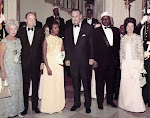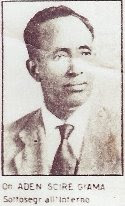January 27, 2014: Al Shabaab continues to survive because their appeal to Somali nationalism, and the idea that Somalis are superior to all their neighbors (which is one reason Somalis have been preying on their neighbors for centuries) appeals to enough young men to provide new recruits. Aligning itself with al Qaeda brings in foreign recruits and cash donations. This is not unique in Somali history, mainly because Somalis have something of an attitude problem. This is a combination of an attitude of superiority (simply by being Somali) and an ethical code that tends towards “what’s mine is mine and what’s yours is negotiable.” Thus Somali migrants tend to get into trouble with the law a lot wherever they end up and are among the most unpopular migrants. Somalis denounce this as discrimination, racism, jealousy or whatever they can get away with. In short, Somalis do not play well with others or each other.
The Somali pirates have been beaten but are still out there. The Somali pirates captured no ships in 2013. Compare that to 2012 when 14 were taken, 2011 when 28 were, 2010 saw 47 grabbed and 2009 had 46 hijacked. Each of these ships yielded, on average, several million dollars in ransom. That kind of money attracted a lot more people to the business. Most of those eager seagoing brigands have sought other work. Meanwhile the “Pirate Coast” (where pirates are most active) is now off West Africa in the Gulf of Guinea. Most of the pirates in the Gulf of Guinea are Nigerians and they attacked 31 ships and briefly hijacked nine of them in 2013. The Nigerian pirates have no safe place to keep captured ships while a large ransom is negotiated. Instead they rob ships they attack and quickly leave. In some cases they arrange to hijack much of the cargo, usually at sea, by transferring to another ship at night and then scampering away before the navy or police show up. Sometimes a few of the ships’ officers are kidnapped for ransom. Off Somalia the pirate threat continues to cost shipping companies several billion dollars a year in additional costs. This is passed on to their customers and boosts shipping expenses less than one percent overall (but several percent for some East African customers).
In the south, along the Kenyan border the 3,400 Kenyan peacekeepers and their clan militia allies have brought a sense of peace and security largely absent from the area for twenty years. The effectiveness of these efforts can be measured by the growing number of Somali refugees returning from a huge (over 500,000 people) refugee camp just across the border in Kenya. Despite that success not enough of those refugees are leaving and Kenya is at odds with the UN over what to do. Kenya fears a lot of the refugees want to settle permanently in Kenya and given problems with Al Shabaab terror attacks in Kenya over the last few years there has been a popular backlash against Somalis in Kenya (and elsewhere in Africa). There is growing tension between Kenyan Christians and Somalis. About ten percent (4 million) of Kenyans, mostly along the coast, are Moslem and most of these are ethnic Somalis. There has always been some Islamic radical activity among Kenyan Moslems, but the police have been particularly attentive to it after Kenyan Moslems were found to be involved in terrorist operations in the 1990s.
To the north of the border region Somali government forces and foreign peacekeepers struggle to control bandits and al Shabaab. Sometimes it is difficult to tell these two groups apart. Both establish illegal roadblocks and rob those who come along. The government has promised to eliminate these illegal roadblocks but that is proving to be a hard promise to keep. The best thing the security forces have going for them is the growing unpopularity of al Shabaab. The Islamic terrorist groups used to have a lot of popular support because of the security the group imposed and their religious demeanor. That all went away when al Shabaab sought to impose strict (and very unpopular) lifestyle rules and many of the al Shabaab gunmen became as troublesome as the bandits (who have always been a problem in Somalia, where many feel it is OK to steal from others as long as they belong to a different clan.)
January 26, 2014: In the south an American UAV missile attack hit a vehicle and killed an al Shabaab leader (Sahal Iskudhuq) and his driver. This is the first such attack since last October, when the top al Shabaab bomb maker was killed.
January 24, 2014: Today was the deadline al Shabaab set for Somali cell phone service providers to shut down Internet (and email) access. In southern Somalia one provider (the largest one) complied but another provider did not. Al Shabaab is checking people’s phones at roadblocks and taking phones and sometimes detaining the owners of those whose phones can still receive data. The government had asked the cell phone providers not to comply. Al Shabaab said it was imposing the ban to limit American spying on their members. For years al Shabaab condemned the use of cell phones that could access the Internet because it was un-Islamic (access to porn and the like) but never went this far to enforce the prohibition (mainly because so many of their own members used the Internet, sometimes for Islamic terrorism related matter). Al Shabaab had issued its order on the 9th.
January 21, 2014: The 4,000 Ethiopian troops who have been operating in western Somalia for the last two years have officially joined AMISOM (African Union mission in Somalia), the UN recognized peacekeeping force. In response to this al Shabaab said it would increase its terrorist attacks. It’s always popular in Somalia to say something bad about Ethiopia. The Somalis have fought Ethiopians for over a thousand years, in part because they are not Somali and in part because they are Christian. What the Somalis dislike most about the Ethiopians is that the Ethiopians usually win these battles and continue to do so.
January 18, 2014: A container ship off Eritrea sent out a call for help, reporting that it was under attack by pirates. It later turned out that the “pirates” were Eritrean coast guard who did board the ship and ordered the captain to go to an Eritrean port.
January 17, 2014: An oil tanker 76 kilometers off Oman alerted nearby warships that pirates were attacking. The armed security guards on the tanker chased the pirates off. This was the first Somali pirate attack of 2014. The next day ships of the anti-piracy patrol found an Indian dhow (a seagoing wooden sailing ship that usually carries under 1,000 tons of cargo) that had been captured by pirates about a week ago. The dhow was boarded by armed sailors and five pirates arrested and the 11 man crew freed.
January 16, 2014: Somalia and Uganda signed an agreement to cooperate in intelligence sharing and anti-terrorism activities.
January 10, 2014: The U.S. admitted that it had stationed a small group of U.S. Army Special Forces in Mogadishu last October. These troops are there to help train Somali military forces. This is the first official presence of American troops in Somalia since 1993. There have been many unofficial visits by Special Forces troops, usually from a special operations base in neighboring Djibouti for over a decade. The CIA has had an unofficial (but very real) base in Mogadishu since at least 2011.
January 9, 2014: In the southwest (Gedo) a remotely controlled bomb went off in a tea shop, wounding four people. It’s unclear who did this. Elsewhere in the area Kenyan warplanes bombed an al Shabaab camp, killing at least 30 al Shabaab men and wounding many others, including some civilians. Many al Shabaab men had gathered for some kind of meeting.




.jpg)











No comments:
Post a Comment